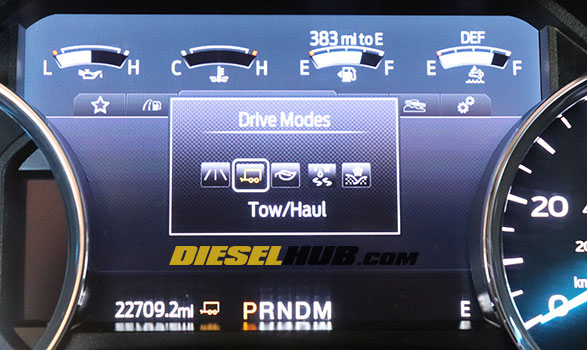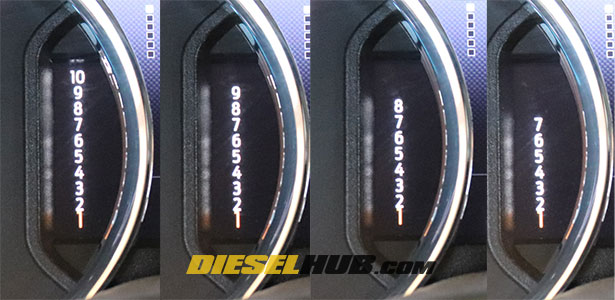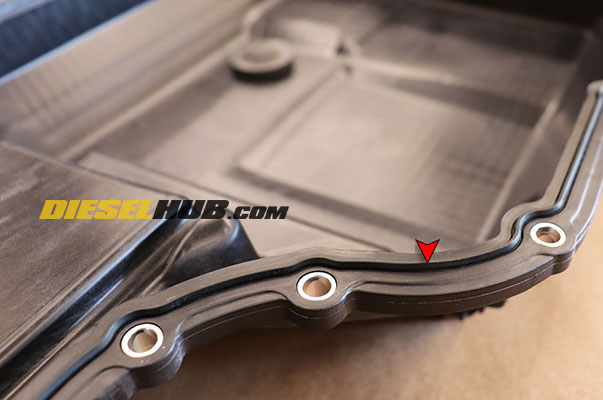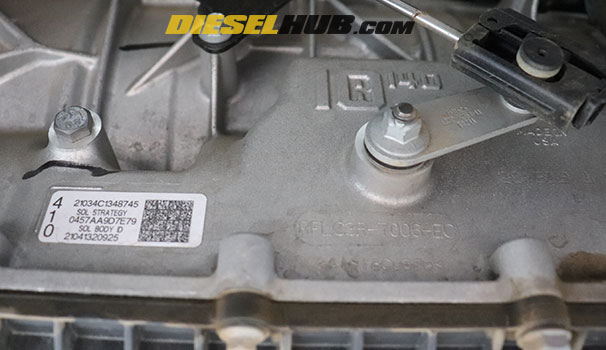The 10R140 TorqShift is a ten speed automatic transmission engineered and manufactured by Ford Motor Company for the Ford Super Duty platform. Beginning with the 2020 model year, the 10R140 is standard on all Super Duty pickup and chassis cab truck models. The transmission delivers next-level power delivery and efficiency management by allowing the engine to remain within an ideal engine speed range that meets the demands of driving conditions. The combination of a low first gear, small steps between gears, and a total of three overdrive ratios allows the transmission to compliment the engine's capabilities in an array of driving scenarios and terrain types.
The 10R140 replaced the 6R140 TorqShift as the standard transmission in all Ford Super Duty models equipped with the 6.7L Power Stroke diesel or 7.3L gas V-8. The 10 speed TorqShift transmission has not been offered in F-650 and F-750 medium duty models and the 6R140 6 speed automatic remains standard in these applications. Like previous transmissions sharing the "TorqShift" namesake, Ford's 10 speed utilizes an adaptive learning strategy that perpetually monitors transmission function and modifies shift parameters as necessary to generate positive, seamless gear changes in all driving conditions.
The transmission also features several driving modes which, when selected, alter the transmission shift schedule based on road conditions (or lack thereof) relative to that driving mode. The selectable drive modes include normal, tow/haul, economy (eco), and deep sand/snow; they are initiated via a control button integrated into the column mounted gear shifter. A manual shift mode allows the driver to control upshifts and downshifts (with safety deterrents in place) with "+" and "-" buttons conveniently mounted on the column shift lever.
The transition from a transmission with 6 forward gears to 10 forward gears is beneficial in that reduces the steps between gear ratios and provides a larger overall range of ratios to select from based on real-time driving conditions. Additionally, it theoretically allows for a shorter 1st gear ratio and taller final drive ratio without necessitating large steps between gear shifts. The 10R140's relatively low 4.615 to 1 first gear ratio provides plenty of torque multiplication off idle while its 0.632 final overdrive ratio offers low engine RPM and efficiency at highway speeds.
The 10R140 TorqShift is not to be confused with the Ford 10R80 (GM 10L80) 10 speed automatic transmission co-developed between General Motors and Ford Motor Company, nor is it an adaptation of this lighter duty transmission. Both the gear spread and physical design of the two 10 speed transmission differs significantly and there are minimal, if any shared components. Additionally, the 10R140 is not related to GM's 10L1000 10 speed transmission, which is found in 2020 to current GMC Sierra and Chevrolet Silverado applications equipped with the 6.6L Duramax diesel. For additional information, see Ford 10R80, GM 10L80 and GM Allison 10L1000 transmission pages.
Ford 10R140 TorqShift 10 Speed Specs
Designation: |
Ford 10R140 TorqShift, "TorqShift 10" |
|
Type: |
10 speed automatic transmission, rear wheel drive |
|
Predecessor: |
Ford 6R140 TorqShift |
|
Applications: |
2020 - current Ford F-250, F-350, F-450 pickup trucks (standard on 6.7L Power Stroke diesel & 7.3L gas V-8) |
|
Production Plant(s): |
Ford Motor Company Sharonville Transmission Plant, Sharonville, Ohio |
|
Overall Ratio/Total Ratio Spread: |
7.30 |
|
Gear Ratio Range: |
4.62 - 0.63 |
|
Average Gear Step: |
25% |
|
Control Type: |
Electronic shift solenoid and line pressure control via Transmission Control Module (TCM) |
|
Torque Converter Lockup: |
Yes, gears 2 through 10; electronic TCC solenoid |
|
Stall Ratio: |
1.97:1 |
|
Max Input Torque: |
1,400 N-m (1,033 ft-lbs) nominal max input torque rating |
|
Case Material: |
Cast aluminum, composite transmission fluid pan |
|
Transmission Weight: |
339 - 347 lbs (slight difference between 2WD and 4WD vehicles) |
|
PTO Provisions: |
Optional stationary and mobile ("Live-Drive") PTO capabilities, split shaft compatible (PTO provisions require order code 62R) |
|
PTO Flange Type: |
10 bolt |
|
PTO Flange Location: |
Driver side of transmission |
|
PTO Drive Type: |
Direct spline to torque converter impeller hub |
|
PTO Gear Ratio: |
0.885:1 (PTO speed 1,130 rpm @ 1,000 rpm engine speed) |
|
Max PTO Output: |
6.2L gas |
250 lb-ft stationary, 115 lb-ft mobile, 40 hp continuous |
7.3L gas |
250 lb-ft stationary, 125 lb-ft mobile, 40 hp continuous |
|
6.7L diesel |
300 lb-ft stationary, 200 lb-ft mobile, 60 hp continuous |
|
Normal Operating Temperature: |
195 - 215° F |
|
Service Intervals: |
Replace transmission fluid and filter every 150,000 miles |
|
Transmission Fluid Type/Spec: |
Motorcraft/Ford MERCON Ultra Low Viscosity (ULV) automatic transmission fluid |
|
Transmission Fluid Capacity: |
18.1 - 18.2 U.S. quarts total transmission fluid capacity [1] |
|
Transmission Filter: |
Motorcraft FT-221 (Ford LC3Z-7G186-A); sump filter |
|
Transmission Pan Gasket: |
Ford LC3Z-7F396-C |
|
Transmission Pan Magnet: |
E9TZ-7L027-A |
|
[1] - Dry fill capacity; service refill may vary considerably.
10R140 TorqShift Transmission Features
Selectable Drive Modes
The 10R140 features several selectable drive modes that optimize various system settings for specific types of terrains. Drive modes are selectable by pressing and releasing the button mounted the column shift lever until the preferred driving mode is selected in the instrument panel display. These selectable drive modes alter a combination of accelerator pedal sensitivity, transmission shift schedule, traction/stability control settings, and electronic locking rear differential status (for applicable vehicles). Any driving mode that reduces traction/stability control performance will illuminate the traction control "OFF" indicator in the instrument cluster display when that driving mode is active. Note that the names of some driving modes vary between model years, but the operational concepts have remained the same. The available drive modes for the 10R140 equipped Ford Super Duty are listed below.

Figure 1 - Selectable drive modes
Drive mode selection is viewable in the instrument cluster display
Normal
Default driving mode, delivers a balance between performance and fuel economy with normal accelerator pedal responsiveness and transmission shift points.
Eco (Economy)
Economy mode reduces accelerator pedal sensitivity (significantly) and offers a transmission shift schedule with shift points at lower engine speeds. The Eco drive mode may give the driver a sense of reduced power, however this is due to the lower upshift points and desensitized accelerator; conservative drivers may observe little change in this drive mode.
Tow/Haul
Tow/Haul mode optimizes engine braking performance and tailors the transmission shift schedule to towing. The transmission may hold gears longer, initiate upshifts at higher engine speeds, and refrain from shifting into overdrive for longer periods; shift schedule adjustments are dependent on the size of the trailer/load and transmission behavior will differ for different combined weights.
Deep Snow/Sand
This drive mode automatically activates the electronic rear locking differential, if equipped, optimizes accelerator pedal sensitivity, and alters the vehicle stability/traction control settings.
Slippery
Ideal for slippery conditions including ice and snow; reduces accelerator pedal sensitivity to help resist overpowering in slippery terrain and optimizes the transmission shift schedule to such conditions.
Rock Crawl
When selected, Rock Crawl mode prompts the driver to engage the four wheel drive system. The electronic rear locking differential is automatically engaged in this drive mode. Accelerator pedal response and the transmission shift strategy are altered for crawling in rocky, off-road terrain; this drive mode is only available with the Tremor package.
SelectShift
The 10R140's SelectShift allows manual gear selection control using "+" and "-" buttons integrated into the column mounted shift lever after placing the range selector in the "M" position ("M" being an acronym for "manual"). In this mode, pressing the "+" button will initiate a transmission upshift into the next numerically higher gear while pressing the "-" will initiate a transmission downshift into the next numerically lower gear. Gearshifts will occur as commanded by the operator, however the system has two safety features. Firstly, if engine RPM drops too low, the transmission will initiate a downshift without operator input to prevent the engine from lugging and/or creating stall conditions. Secondly, the transmission will not complete an operator commanded downshift if the current conditions will produce an engine over-rev scenario; in this instance, the downshift will be completed only after engine speed has reduced enough to prevent an over-rev condition in the lower gear. In manual mode, the transmission will NOT upshift unless commanded by the operator, regardless of engine RPM.
Also integrated into the SelectShift system is Progressive Range Selection (PRS), which is integrated into the normal "D" range position. PRS allows the operator to set the maximum gear that the transmission will shift to; transmission function is otherwise normal and upshift/downshift conditions are unaltered. PRS settings are made with the range selector in "D" using the "+" and "-" buttons on the column mounted shift lever. By default, gear numbers 1 through 10 are illuminated in the instrument panel display. Pressing the "-" button once will display gear numbers 1 though 9 in the instrument panel and the transmission will not complete the 9 to 10 shift, regardless of driving conditions. Pressing the "-" button once more will display gear numbers 1 through 8 in the instrument panel and the transmission will not complete the 8 to 9 or 9 to 10 shifts; the highest number displayed in the instrument cluster is the highest gear that the transmission will shift into. These actions are revered by pressing the "+" button until the desired highest gear is displayed in the instrument panel, up to 10. This function is extremely useful when towing and any 1 of the 3 overdrive gears are not desired for the load and terrain conditions. Additionally, overdrive gears can be canceled to help the vehicle warm up faster when driving in cold weather.

Figure 2 - Progressive Range Selection (PRS)
PRS allows you to set the highest gear that the transmission will shift to
From left to right: max 10th gear, max 9th gear,
max 8th gear, max 7th gear
Adaptive Learning Strategy
The 10R140's adaptive shift strategy is similar that employed in the previous 5 and 6 speed TorqShift transmission models. It intends to provide the driver with seamless engagements by perpetually monitoring shift events and making necessary adjustments to the shift schedule for various driving conditions, essentially learning how to improve shift quality with every shift that the transmission makes. Additionally, the system maintains shift quality as the transmission ages as these adjustments compensate for long term wear, particularly changes in clutch pack engagement behavior.
10 Forward Drive Ratios
The 10R140 features 10 forward gear ratios, which translates into small steps between gears (25% on average) and an ideal gear ratio for any terrain and any situation. Most importantly, the small gear steps keep the engine within an ideal operating range, maximizing available torque and eliminating the large drop in output to the drive wheels when shifts are performed. Furthermore, the 10R140 utilizes 3 overdrive ratios (0.85, 0.687, and 0.632) to keep engine speeds low when the vehicle has reached its cruising speed and eliminating the unfavorable situation where a transmission grabs its tallest gear too earlier for the current engine load. Lastly, the available gear ratios reduce gear hunting and engine lugging by taking small steps that don't require large drops in engine speed.
Direct Acting Shift Solenoids
Direct acting linear shift solenoids manage the shift and torque converter clutch functions in the 10R140. Unlike a traditional shift solenoid, which allow or inhibit flow through an integrated valve in the shift solenoid assembly, direct acting solenoids actuate a separate mechanical valve integrated into the valve body. Separating the solenoid and valve is believed to result in a more reliable fluid control system with more consistent shift performance.
Live-Drive PTO System
The 10R140 Live-Drive power take-off (PTO) system is standard on all chassis cab trucks and optional on all pickup truck models. Live-Drive allows PTO operation in both stationary and mobile modes, thus PTO accessories are available whether a vehicle is parked or in motion. This is accomplished through a drive gear that is powered directly off of the engine (torque converter impeller) and operates independently of the torque converter turbine. On trucks equipped with the 6.7L Power Stroke diesel, the system offers up to 300 lb-ft of PTO torque in stationary mode and 200 lb-ft of torque in mobile mode.
Ultra-low Viscosity Automatic Transmission Fluid
All 10R140 transmissions require MERCON Ultra Low Viscosity (ULV) automatic transmission fluid. The low viscosity lubricant minimizes parasitic power waste through the transmission by reducing pumping and windage losses. MERCON ULV is not cross-compatible with previous or coinciding MERCON ATF products, thus repairmen should be attentive when selecting and adding fluid to this transmission.
10R140 Transmission Identification
The 10R140 is often confused with the Ford model 10R80 transmission and is commonly misquoted as being a relative of the Allison 10L1000 ten speed automatic transmission employed behind GM's 6.6L Duramax diesel. The light duty Ford 10R80 and GM 10L80 ten speed automatic transmissions are indeed the result of a joint venture between GM and Ford Motor Company, and thus there is significant parts commonality between the two transmissions. The GM-Allison 10L1000 and Ford 10R140 are two entirely different 10 speed automatic transmissions with zero parts commonality, alternative gear ratios, and separate transmission features.
The 10R140 is quickly identified by its composite fluid pan, which secures to the bottom of the transmission with 20 metric bolts (see figures 3 and 4 below). Additionally, the 10R140 oil cooler is uniquely mounted beneath the bellhousing of the transmission (see figure 6 below). A heat shield protects the passenger side the transmission pan from heat radiating off the exhaust aftertreatment system. The fluid pan features a large, serviceable o-ring type gasket (figure 5 below) secured within a integral groove in the fluid pan mounting flange.

Figure 3 - 10R140 transmission pan interval view
Note that the magnet is attached to the pan with a spring clip since the pan is produced from a composite, non-magnetic material

Figure 4 -10R140 transmission pan bottom view
The honeycomb structure of this fluid pan adds rigidity and likely aids in dissipating heat

Figure 5 - 10R140 transmission pan gasket closeup view
The o-ring type gasket is seated inside of a groove integrated into the transmission pan flange

Figure 6 - 10R140 transmission cooler location
A 10R140 logo is also cast into the transmission case near the range selection shift lever on the driver side of the transmission. Additionally, the transmission part number and shift solenoid information labels are visible in this general region (see figure 7 below). A large connector travels through the case near the rear of the transmission on the driver side and attaches to the chassis wiring harness (see figure 8 below).

Figure 7 - 10R140 transmission designation and logo cast into the transmission case

Figure 8 - 10R140 electrical connector located on the drivers side near the rear of the transmission case
10R140 TorqShift 10 Speed Gear Ratios
Gear |
Ratio |
1st |
4.615 : 1 |
2nd |
2.919 : 1 |
3rd |
2.132 : 1 |
4th |
1.773 : 1 |
5th |
1.519 : 1 |
6th |
1.277 : 1 |
7th |
1.00 : 1 |
8th |
0.85 : 1 |
9th |
0.687 : 1 |
10th |
0.632 : 1 |
Reverse |
4.695 : 1 |
10R140 Gear Steps (Percent Step)
Gear Change |
Step |
1st to 2nd |
58% |
2nd to 3rd |
37% |
3rd to 4th |
20% |
4th to 5th |
17% |
5th to 6th |
19% |
6th to 7th |
28% |
7th to 8th |
18% |
8th to 9th |
24% |
9th to 10th |
9% |
10R140 Solenoid Apply Chart
Gear/Position |
SSA |
SSB |
SSC |
SSD |
SSE |
SSF |
TCC |
P |
on |
on |
off |
on |
off |
off |
off |
R |
on |
on |
off |
on |
off |
on |
off |
N |
on |
on |
off |
on |
off |
off |
off |
1 (D) |
on |
off |
off |
on |
on |
off |
off |
2 (D) |
on |
off |
on |
on |
off |
off |
on/off |
3 (D) |
on |
off |
on |
on |
on |
off |
on/off |
4 (D) |
on |
off |
on |
on |
off |
on |
on/off |
5 (D) |
on |
off |
on |
off |
on |
on |
on/off |
6 (D) |
on |
off |
off |
on |
on |
on |
on/off |
7 (D) |
off |
off |
on |
on |
on |
on |
on/off |
8 (D) |
off |
on |
off |
on |
on |
on |
on/off |
9 (D) |
off |
on |
on |
off |
on |
on |
on/off |
10 (D) |
off |
on |
on |
on |
off |
on |
on/off |
SSX = shift solenoid "A", shift solenoid "B", shift solenoid "C", etc
TCC = torque converter clutch lockup solenoid
10R140 TorqShift Adaptive Strategy Drive Cycle
The 10R140's adaptive strategy requires encountering a variety of drive cycles and driving conditions to properly generate an optimized shift strategy schedule. This shift schedule is perpetually updated to account for transmission wear and changes in transmission shift behavior. Certain actions, particularly those related to the vehicle losing battery power, will clear the TCM memory and the transmission will need to "relearn" its optimal shift parameters. Any of the following actions/conditions will require the adaptive strategy drive cycles to be performed:
• Significant transmission or engine repairs or replacement are performed
• Transmission control module is removed, replaced, or reprogrammed
• Keep alive memory (KAM) is lost (KAM memory is lost if batteries are disconnected or modules are reflashed/reprogrammed; replacing batteries will result in loss of KAM)
While the adaptive strategy will relearn naturally through normal operation, this may take several thousand miles of driving under various conditions for the transmission shift patterns to normalize. During the relearn period, the transmission may hunt for gears, select a gear that is undesirable for the driving conditions, or shift with random inconsistencies. The following procedures will complete the adaptive learning drive cycles and reduce the prevalence of such conditions while an optimized shift schedule is being generated.
1) Check for DTCs with an appropriate scan tool. Perform repairs relevant to any active DTCs and clear any DTCs that remain after repairs have been performed.
2) Clear the transmission adaptive tables with an appropriate scan tool or leave both negative battery cables disconnected for a minimum of 1 hour (note - a DTC P1000 will be set until all emissions related drive cycles have been completed; this is normal and will not prevent the adaptive strategy relearn process).
3) Drive the vehicle with conservative accelerator pedal inputs until the transmission and engine reach normal operating temperature.
4) On a level road, accelerate from a stop with light accelerator input (approximately 15%) and verify that upshifts from first through 8th occur at an engine speed between 1,300 and 1,600 rpm (the accelerator can be feathered while attempting to meet these requirements).
5) After the 7th to 8th gear upshift completes (current transmission gear can be monitored in the PRS display in the instrument cluster), increase accelerator pedal input and continue to accelerate until the vehicle is traveling at least 55 mph and then allow the 8th to 9th and 9th to 10th upshifts to complete if they have not yet occurred.
6) Brake gently to a complete stop and keep the brake pedal depressed for 5 seconds.
7) Shift the transmission into the neutral position, then wait 1 second.
8) Shift the transmission into reverse, then wait 2 seconds.
9) Shift the transmission back to neutral, then wait 1 second.
10) Shift the transmission back into drive (D).
Repeat steps 4 through 10 six additional times to complete the adaptive learning drive cycles.
Summary & Key Points
• The 10R140 is a heavy duty, 10 speed automatic transmission developed by Ford Motor Company for the Ford Super Duty platform.
• All 2020+ model year Ford F-250, F-350, F-450, F-550 Super Duty models equipped with the 6.7L Power Stroke diesel or 7.3L gas V-8 are mated to the 10R140 TorqShift transmission.
• The advantage of the transmission's 10 forward speeds is its ability to keep the engine within an ideal RPM range to maximize performance and/or efficiency under diverse conditions.